No matter how far we travel or how long we’ve been away, there’s something powerful about the taste of home. For many in the diaspora, one of the deepest connections to our roots isn’t through language or clothing, it’s through food.
That first spoon of egusi, the smoky aroma of suya, or the comforting heat of pepper soup can instantly transport you back to a childhood kitchen, a street food corner, or a family gathering filled with laughter.
We’re taking you on a flavorful journey through the traditional Nigerian (and West African) dishes every diasporan should experience again or discover for the first time. Whether you’re looking to recreate these meals abroad or just feel more rooted in your culture, these dishes are more than food, they’re memory, identity, and love served on a plate.
Top Traditional Dishes to Reconnect With In Diaspora
1. Jollof Rice
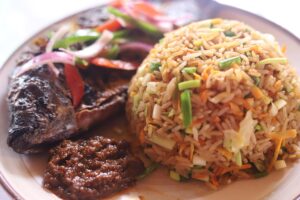
No list of traditional dishes is complete without Jollof Rice a dish so iconic, it’s sparked decades-long debates across West Africa and within the diaspora. Whether it’s the smoky party-style version cooked over firewood or a milder, home-cooked plate, Jollof is more than food, it’s a cultural statement.
At its heart, Jollof is a simple tomato-based rice dish, but every region and even every family, has its own twist. Nigerian Jollof is bold, spicy, and full of depth thanks to a rich blend of tomatoes, bell peppers, onions, and local seasonings. It’s often served with fried plantain, grilled chicken, beef, or fish, and enjoyed at everything from weddings to Sunday lunches.
For diasporans, Jollof Rice is a memory on a plate. It brings back sounds of loud music at family parties, the clinking of coolers, and the unmistakable smell of stew that hits before you even reach the front door. Cooking or eating Jollof abroad is often the first step many take in reconnecting with home, it’s comfort food with pride cooked into every grain.
And yes, if you’re wondering, Nigerian Jollof still reigns supreme (but feel free to start a friendly war in the comments).
2. Egusi Soup with Pounded Yam or Fufu
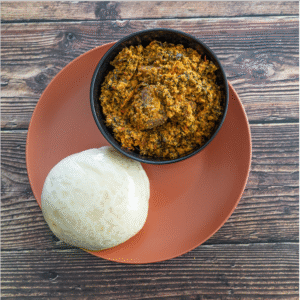
Thick, hearty, and packed with flavor, egusi soup is made from ground melon seeds, slow-cooked with palm oil, vegetables (usually spinach or bitterleaf), assorted meats, and sometimes seafood. It’s a staple across many Nigerian households, especially in the southwest and southeast.
What makes egusi unforgettable isn’t just the rich texture or spicy undertones, it’s the ritual of eating it. Tearing off a piece of soft, stretchy pounded yam or fufu with your fingers, dipping it into the soup, and letting the flavors coat your palate feels like a cultural homecoming. It’s communal, comforting, and deeply symbolic of Nigerian hospitality.
For many in the diaspora, egusi soup is often the first dish they learn to recreate abroad. Its ingredients, though traditionally sourced, can often be substituted without losing too much of its soul.
Whether you’re using goat meat, stockfish, or even a vegan alternative, one thing remains: Egusi is home in a bowl.
3. Suya

Originating from Northern Nigeria, Suya is a spicy grilled meat skewer typically made with beef, goat, or chicken, seasoned with a dry rub known as yaji, a flavorful mix of ground peanuts, cayenne pepper, ginger, garlic, and other local spices.
What makes Suya special isn’t just the taste; it’s the ritual. In cities like Lagos, Abuja, or Kaduna, Suya isn’t just foo, it’s an experience. Whether you’re buying it late at night from your favorite Mai Suya (Suya seller), wrapped in old newspaper and served with slices of onion and fresh tomatoes, or sharing a plate during a hangout, Suya evokes a sense of community and nostalgia that’s hard to describe but easy to feel.
For those in the diaspora, Suya becomes more than just meat on a stick, it’s a flavor of home. It’s what you crave at midnight after a long day. It’s what you try to recreate at BBQs, hoping the yaji spice you found online hits the same. It’s also one of the easiest traditional Nigerian dishes to introduce to non-Africans: bold, smoky, spicy, and deeply satisfying.
4.Moi Moi or Akara

Both made from blended beans, these dishes are staples that hold a special place in our culinary heritage and in the hearts of diasporans who grew up with them.
Moi Moi, a steamed bean pudding often wrapped in leaves or served in bowls, is a delicate and protein-rich dish that pairs beautifully with jollof rice, custard, or simply on its own. It’s a symbol of care and patience, made with love, spices, onions, oil, and sometimes filled with extras like boiled egg, fish, or corned beef.
Akara, on the other hand, is the crunchy-on-the-outside, fluffy-on-the-inside version. Commonly eaten as breakfast or street food, it’s served with pap (ogi), bread, or custard. For many diasporans, making Akara is a doorway to simpler times, of watching mom or grandma fry a batch at dawn before school, or buying them wrapped in newspaper from the roadside vendor.
5. Ogbono or Okra Soup
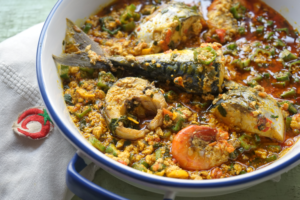
There’s something deeply personal about the texture of Ogbono or Okra soup. For many Nigerians—whether at home or in the diaspora. – It’s one of those meals that immediately says “you’re home.” Known for its unique “draw” or slippery consistency, this soup is often misunderstood by those who didn’t grow up with it, but it remains a beloved staple in many households.
Ogbono soup, made from ground wild mango seeds, is earthy, thick, and hearty. It’s often paired with meats, fish, or stockfish, and simmered in a richly seasoned broth. The result? A flavorful, sticky soup that coats every bit of swallow (like pounded yam or amala) and brings satisfaction in every bite.
Okra soup, on the other hand, is lighter but equally delicious. Made from finely chopped or grated okra pods, it’s often mixed with leafy vegetables, peppers, and proteins. When cooked right, it’s vibrant, colorful, and deeply nourishing, especially popular among children and elders alike for how easy it goes down.
6. Pepper Soup
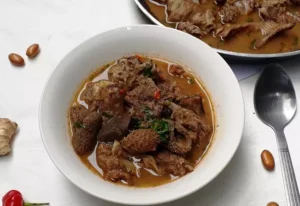
Spicy, aromatic, and soul-warming, pepper soup is more than just a dish it’s an experience. Made with a medley of local spices like ehuru (calabash nutmeg), uda, and alligator pepper, this light, broth-based soup is often served during life’s most sacred moments. Whether it’s a naming ceremony, postnatal care, or a quiet rainy day at home, pepper soup is always there, comforting, cleansing, and connecting.
Traditionally prepared with goat meat, catfish, or even assorted parts, the beauty of pepper soup lies in its simplicity and its ability to feel both deeply local and widely loved. For diasporans, it brings back memories of family gatherings, mother’s touch, or the communal silence that falls when the heat kicks in mid-spoonful.
You can recreate pepper soup abroad by shopping at African or Caribbean grocery stores for spice mixes or making your own blend. If you’re new to it, start with fish pepper soup, it’s faster to prepare and still delivers the full nostalgic punch.
7. Banga Soup or Ofe Akwu
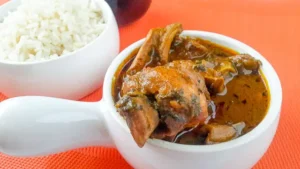
Banga Soup is traditionally cooked with a special blend of native spices like beletete, ataiko, and oburunbebe sticks, giving it a deeply earthy and distinct flavor profile. It’s commonly served with starch, eba, or fufu, and often includes fresh catfish, dried fish, or assorted meats.
Ofe Akwu, on the other hand, leans more into Igbo culinary tradition. It’s often paired with white rice instead of swallows and typically features fewer native spices, focusing more on flavor from stockfish, smoked fish, and crayfish. Its richness and thickness make it a beloved Sunday meal in many Igbo homes.
For diasporans, making Banga Soup or Ofe Akwu is more than just cooking, it’s reliving a Sunday afternoon in Grandma’s kitchen or recreating the meal from a festive homecoming. With canned palm fruit concentrate now widely available abroad, these soups have become easier to replicate no matter where you live.
8. Tuwo Shinkafa with Miyan Kuka
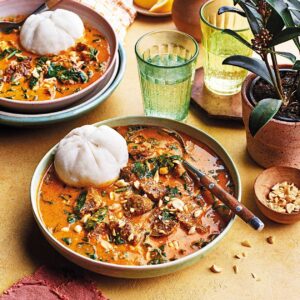
Tuwo Shinkafa is a soft rice pudding made from short-grain rice, cooked until mushy and molded into smooth balls, similar in texture to swallow. It’s simple, filling, and perfectly designed to soak up the rich, green, slightly smoky magic of Miyan Kuka.
Miyan Kuka, also known as baobab leaf soup, is made from dried and ground baobab leaves, with ingredients like dried fish, beef, dawadawa (fermented locust beans), and sometimes okra or yaji (dry pepper blend). The result is a hearty, earthy, and distinct soup that instantly reminds Northern Nigerians of home.
How to Recreate These Dishes Abroad
Recreating traditional dishes while living abroad can feel like a challenge, but it’s one of the most powerful ways to stay connected to your roots. Whether you’re craving the taste of home or hoping to introduce your culture to others, the good news is that many Nigerian ingredients are now widely available, even outside Africa.
Ethnic grocery stores, African or Caribbean markets, and online platforms like Amazon now stock essentials such as palm oil, egusi seeds, ogbono, crayfish, iru (locust beans), yam flour, stockfish, and more. Joining local diaspora Facebook groups or WhatsApp communities can also help you discover nearby stores or vendors who stock what you need.
Once you have your ingredients, the next step is preparation and thankfully, there’s no shortage of guidance. YouTube has become a go-to platform for diaspora-friendly recipes. Creators like Sisi Yemmie, Zeelicious Foods, and Chef Lola’s Kitchen offer clear, step-by-step tutorials using accessible substitutes that still maintain the dish’s original flavor.
 Their videos are particularly helpful for beginners and for those cooking in small kitchens with limited tools. Watching these creators feels like having a family member guide you in the kitchen.
Their videos are particularly helpful for beginners and for those cooking in small kitchens with limited tools. Watching these creators feels like having a family member guide you in the kitchen.
Of course, not every ingredient will be available abroad, so substitutions are part of the experience. Can’t find scotch bonnet? Use habanero or Thai chilies. No bitterleaf? Try kale or spinach, and season generously. Can’t find iru?
A pinch of fermented miso paste can mimic its savory depth. The key is to focus on flavor and cultural connection, not exact replication. A dish that feels like home is just as powerful as one that looks traditional.
Equipping your kitchen with a few essential tools will make recreating these dishes easier. A good blender or food processor is invaluable for soups and moi moi. A mortar and pestle brings you closer to the authentic experience, and a large non-stick pot is perfect for preparing jollof rice or stews. While pounding yam by hand may not be realistic for everyone, pounded yam flour prepared correctly in a microwave or pot still delivers that familiar texture and taste.
Food is always better when shared. Cooking with other diasporans or hosting “Taste of Home” nights is not only fun but emotionally grounding. It’s an opportunity to trade stories, introduce your culture to others, and recreate the communal spirit that defines African mealtimes.
If you’re teaching friends or family members from other cultures, encourage them to eat with their hands and talk about the heritage behind each dish.
And if you’re short on time, there are now vendors and meal services that cater specifically to Africans abroad.
Many cities have frozen Nigerian soups, ready-made stews, and pre-chopped ingredients available for order. Online stores like My Sasun African Store or Naija Food Market are also great resources for buying traditional foods without hassle.
